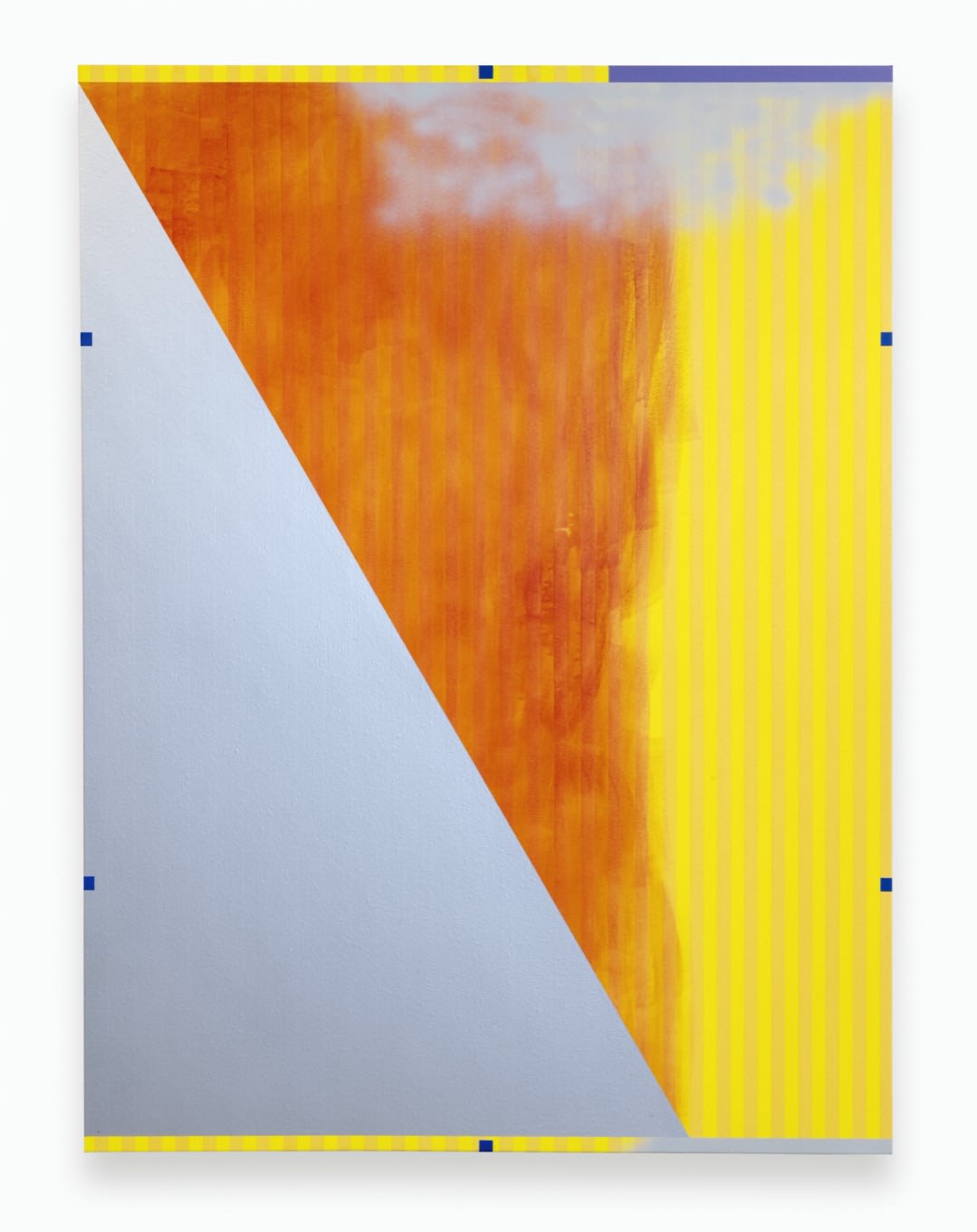First of all, on the surface on which I am going to paint, I draw a rectangle of whatever size I want, which I regard as an open window through which the subject to be painted is seen.
— Leon Battista Alberti, De Pictura, 1435
Liminals is an exhibition of new works by Austrian artist Nick Oberthaler exploring the function of abstract paintings as thresholds for new spatial and visual experiences.
Hanging low on the wall, the four large-scale works conceived specially for Thaddaeus Ropac Paris Marais act as windows into shifting visual dimensions of vivid, contrasting hues, while altering the spaces they inhabit. Alongside them, small, postcard-size works provide a more intimate insight into the artist’s process, revealing his instinctual approach to texture and colour.
In both a physical and figurative sense, paintings have long been associated with windows, their grid-like architecture serving as a model for the geometric observation of nature that led to the development of perspective during the Renaissance by theoreticians such as Alberti. Oberthaler, in his own visual language which draws on minimalism and geometric abstraction, reinterprets the art historical trope, layering it with a contemporary digital dimension to reflect on the structures that underpin the making and consumption of images today.

The artist uses what he refers to as ‘high-pitched colours’ in these works, his fluorescent yellow and silvery grey giving the paintings a distinctly technological appearance. Working in layers as one would on computer design software, the artist juxtaposes this colouristic universe with gestural strokes of terracotta, allowing the two to clash and work together in turn, provoking viewers into an active contemplation.
Untitled (Liminal #2), 2022
Acrylics on canvas
160 x 120 cm (62.99 x 47.24 in)
(NO 2142)

‘It is as if the painting has been folded and unfolded like a page, leaving a mark. The grey part, shiny, with its metallic reflections, creates a distance with the quality of the work itself. Is it “paint”?’ – Curator and art historian Marie de Brugerolle, 2019
Untitled (Liminal #1), 20212
Acrylics on canvas
160 x 120 cm (62.99 x 47.24 in)
(NO 2143)

In this painting, which most explicitly references a window, a ground of ultramarine blue intersected by a deep red grid invokes a palette more commonly found in paintings from the 15th and 16th centuries, echoing the origins of the art historical motif. The lighter blue hue that underscores the structural lines of the work hints at the illusionism of classical perspective, inviting us to peer into the depths of the painting in search of a landscape or a different world.
Untitled (Window), 2022
Acrylics on cotton duck
160 x 120 cm (62.99 x 47.24 in)
(NO 2145)

Throughout the works, geometric forms and spatial indicators challenge and perturb vision as much as they structure it. In this way, Oberthaler reveals the elemental grid also as a barrier to observation: generating a loss of scale that is at once disorienting and freeing.
Untitled (Liminal Landscape #3), 2022
Acrylic on paper
15.5 x 11.1 cm (6.1 x 4.37 in)
(NO 2157)
In 2019, Oberthaler began making smaller works, which he sent to friends, artists and collectors as ‘SOS postcards’ with no writing on the back but the date on which they were made. They became what he calls ‘travelling paintings’, evoking the precedent of Marcel Duchamp’s Box in a Valise (1935–41) in which he carried miniatures of his works, as well as the postal art of the 1960s and 1970s, when artists would send ideas and artworks as a way to avoid censorship and circumvent the rigid structures of the art world.
‘On the one hand these could be ideas for not yet realised works, on the other, they could be seen as zoom-ins or outs: windows offering a view onto a landscape. In the most reduced sense they are simple paintings, questioning compositional parameters and the interplay of colour on a very small picture plane.’
— Nick Oberthaler, 2022

The bands of colour that make up this postcard painting are taken from the Google Maps colour chart of greys, yellows, green and blues. On the top right corner the artist has typeset the letters ‘SO’, and ‘S’ on the bottom left. Together forming a call for help, separately the letters act as coordinates ‘sud-ouest’ (south-west) and ‘south’, echoing the topographical indications that can be found across the larger works on view and hinting at the landscapes that might lie beyond the window-like canvases.
Untitled (SOS), 2021
Acrylics, Letterset and lacquer on paper
11.1 x 15.5 cm (4.37 x 6.1 in)
(NO 2146)

The small, pixel-like squares found on the edges of the paintings resemble the markers found on design software, which act as handholds, allowing users to orient themselves and retain a sense of scale in the immaterial digital universe. In this large-scale painting, the artist uses the same Google Maps colour chart, which, as he explains, informs our experience of landscape and topography today. Evoking train travel and the passing scenery as a reference, he offers viewers a distinctly contemporary approach to the canvas as a window onto a different world.
Untitled (Maps), 2022
Acrylics on canvas
160 x 120 cm (62.99 x 47.24 in)
(NO 2144)
A scientific approach to image-making has fostered the idea of verisimilitude in art since the Renaissance, where the painting acts as a window to a new visual dimension that is nonetheless real. Such an approach continues to influence the way we consume images, particularly those produced by technology, which still lay claim to the objectivity of science.
In Liminals Oberthaler reveals paintings as moving planes of colour and form that – more than portals into new worlds – are spaces of invention, unstable and unconstrained, poised on the edges of reality.

About the artist
Nick Oberthaler was born in Bad Ischl, Austria in 1981. He studied at the Vienna Academy of Fine Arts and the École Supérieure des Beaux-Arts in Geneva, and now lives and works between Austria and Germany. He currently holds a professorship for painting at the École Nationale Supérieure des Beaux-Arts de Lyon. His works are part of important institutional collections, including the 21er Haus / Belvedere, Vienna; LENTOS Kunstmuseum, Linz and the Musée Départemental d’Art Contemporain de la Haute-Vienne, Rochechouart. International exhibitions include Distinct Oscillations Revisited, with Wilfrid Almendra, Adelaïde, Marseille (2018); RIDEAUX/blinds, Institut d’Art Contemporain Villeurbanne/Rhône-Alpes, France (2015); The Blackbird Must be Flying, with Thomas Julier, Centre d’Art Bastille, Grenoble (2014–15); Calculated Reserve, Museo Hendrik Christian Andersen/Galleria Nazionale d’Arte Moderna, Rome (2014); Minimal Myth, Museum Boijmans van Beuningen, Rotterdam and Eventuality of an attempt, KIOSK, Ghent (both 2012).
















































































































































































